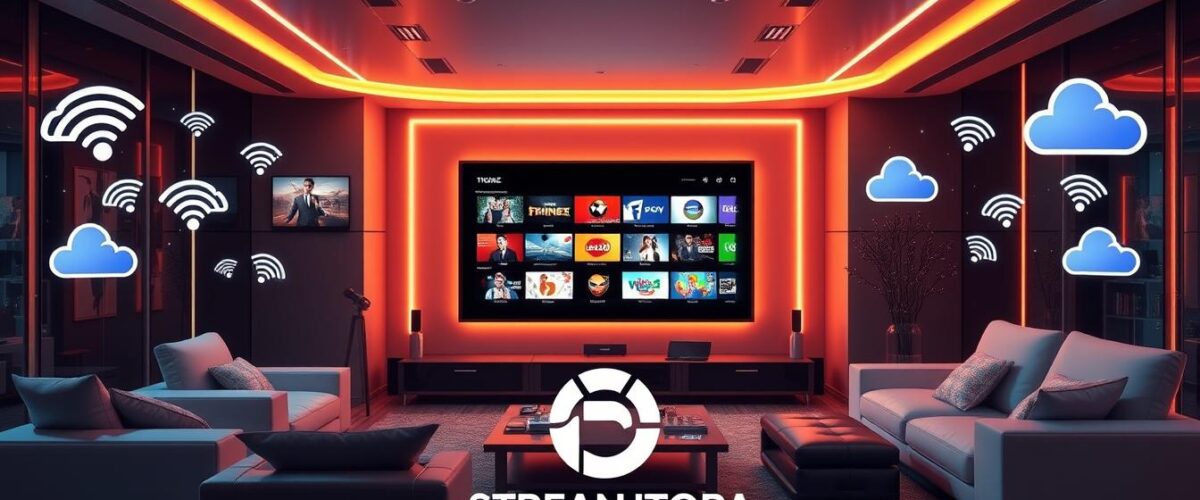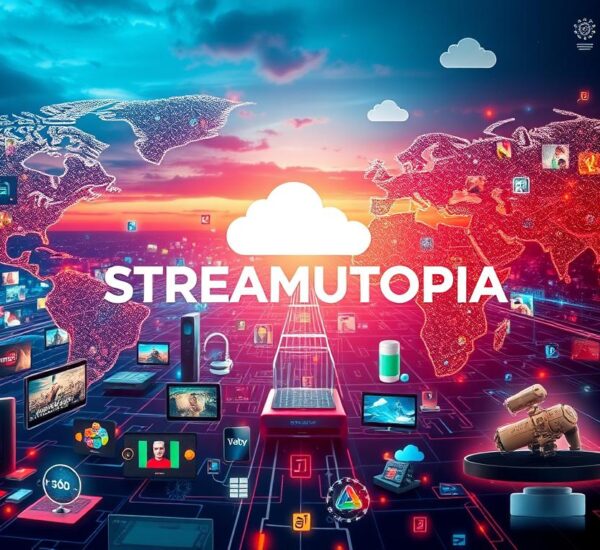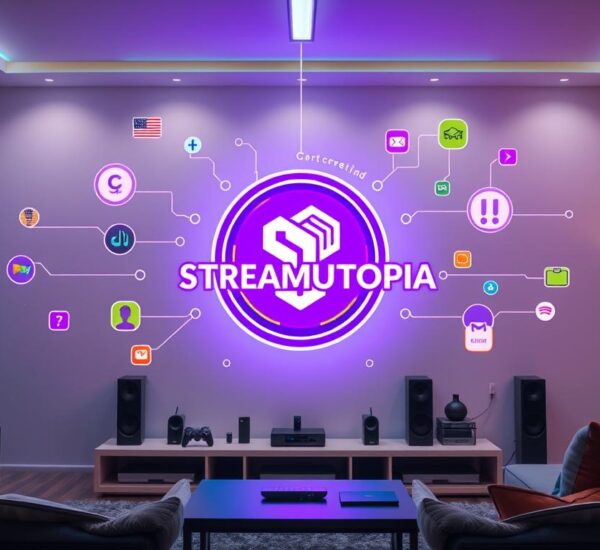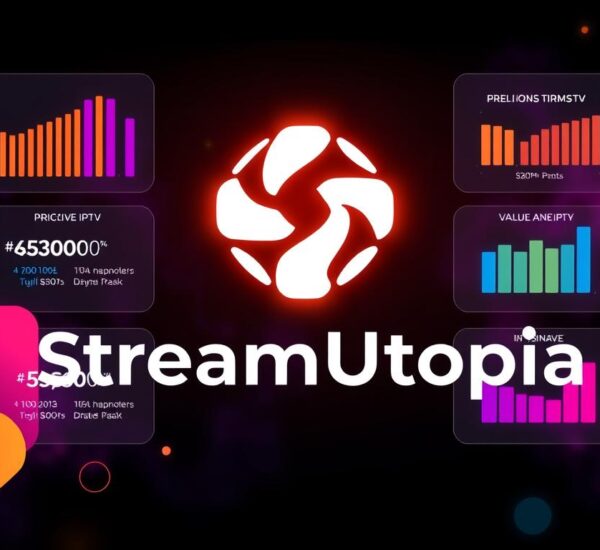Ever thought about TV delivered over the internet, without cable or satellite? That’s what Internet Protocol Television (IPTV) is all about. It changes how we watch TV by streaming video over the internet.
IPTV uses the internet to bring you channels and on-demand shows. It’s different from old TV, which sends one show to many at once. IPTV sends one show to one device, making it better and more reliable. Big names like Verizon and AT&T offer plans that fit what you want to watch.
As we move to watching more online, knowing about IPTV is key. It offers better quality and a huge selection of shows. For more on the latest in streaming, visit Streamutopia.
Key Takeaways
- IPTV uses managed IP networks for better quality and reliability compared to traditional television.
- It delivers content through unicast, providing personalized streaming experiences.
- Major telecom companies like Verizon and AT&T offer various IPTV subscription packages.
- IPTV is rapidly becoming a preferred choice for modern viewers around the globe.
- Understanding IPTV is essential for leveraging its vast content and features effectively.
Understanding IPTV: A New Era of Television
IPTV technology has changed how we watch TV, moving from old-school broadcasts to internet-based viewing. Now, you can watch your favorite shows on many devices, offering more choices than cable or satellite. This change started in 1927 and grew to include cable and satellite in the late 1970s. IPTV brings new flexibility and control to watching TV at home.
IPTV has become more popular as people want more streaming options. It was first talked about in 1995 and uses advanced protocols like RTSP and HTTP. This technology lets you watch Live TV, Video On Demand, and Catch Up TV, meeting today’s viewing needs.
IPTV stands out because it lets viewers watch shows when they want. This is something old TV formats can’t do. The IPTV market is growing fast, with more providers coming in. This shows a move towards content that fits the viewer’s schedule and preferences.
IPTV has improved with better Quality of Service and support for high-resolution content like 4K and HDR. It attracts a wide range of viewers, including sports fans and international audiences. Sports broadcasting is embracing IPTV, with services like FOX Sports Go and Hulu Live TV leading the way. They offer live IPTV services, showing how viewer habits are changing.
To learn more about IPTV’s benefits and how it’s changing TV, check out this guide. The future looks bright for IPTV, blending traditional TV with modern streaming.
What Is Internet Protocol Television (IPTV) and How Does It Work?
Internet Protocol Television, or IPTV, is a new way to watch TV. It lets you stream live TV, movies, and series over the internet. You can watch on TVs, computers, smartphones, and tablets.
In the US, Canada, and Australia, IPTV is getting popular. It’s seen as a good alternative to old TV ways.
Definition and Overview of IPTV
IPTV uses the internet to send TV content instead of satellites or cables. IPTV providers give you access to shows like “Game of Thrones” and “Stranger Things.” IPTV’s design lets you enjoy:
- Live TV
- Video on Demand (VoD)
- Time-shifted media
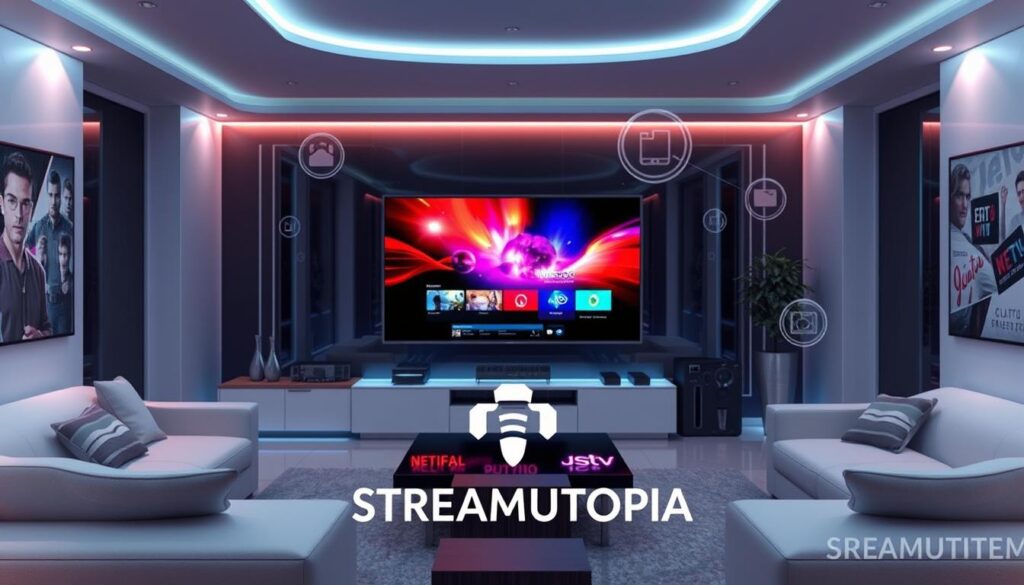
How IPTV Differs from Traditional TV
IPTV is different from old TV because it’s more personal. It sends signals directly to your device, unlike traditional TV. This makes IPTV better in many ways:
- More flexible viewing options
- Watch on many devices at once
- More channels and content
- Use DVR for recording shows
Learning about IPTV shows how it’s changing how we watch TV. It makes watching TV better and more flexible worldwide.
| Feature | IPTV | Traditional TV |
|---|---|---|
| Delivery Method | Internet Protocol | Broadcast Signal |
| Content Access | Multiple devices | Single TV set |
| Content Types | Live, VOD, Interactive | Primarily Live |
| Recording Functionality | Available (DVR) | Limited options |
The Technology Behind IPTV
IPTV technology uses strong IP networks and special protocols for content delivery. It’s a big change from old TV broadcasting to streaming over the internet. Now, people want easy access to lots of content without owning it.
IP Networks and Protocols
The core of IPTV is built on IP networks for quality and reliability. Important protocols like Internet Group Management Protocol help with multicasting. This makes content reach subscribers efficiently.
Protocols like Real-Time Streaming Protocol and Hypertext Transfer Protocol ensure smooth streaming. They work well for both live and Video-on-Demand content. This makes IPTV better than regular internet video streaming.
Streaming Methods: Unicast vs. Multicast
IPTV uses two main ways to send content: unicast and multicast. Unicast sends a stream to one user, great for Video-on-Demand. Multicast, on the other hand, sends data to many users at once, saving network resources.
This means families can watch different TV channels on different sets with just one subscription. It’s a big plus for families.
How IPTV Works
IPTV uses a network of servers to send video data to users. It breaks down video into smaller packets. This makes streaming faster and better.
Users can pick what they want to watch, like movies or shows. They don’t have to look through a long list of channels.
Content Delivery Systems
IPTV’s success comes from its detailed content delivery systems. These systems aim to improve the user experience and keep video streams high quality. Key parts include:
- Packetization: Video data is split into packets for easy sending.
- Streaming Options: It supports live shows and video-on-demand, giving users choices.
- User-Friendly Interfaces: IPTV services have guides and recommendations, making it easy to navigate.
IPTV offers different subscription plans, like monthly or yearly. These plans are cheaper than traditional TV or satellite services. This makes IPTV a popular choice for many.

| Feature | Traditional TV | IPTV |
|---|---|---|
| Content Selection | Limited lineup | On-demand access |
| Flexibility | Fixed schedule | Watch anytime, anywhere |
| Interactive Features | Basic | Advanced EPG and recommendations |
| Network Type | Cable/Satellite | Broadband Internet |
This technology improves how we watch TV and meets today’s high standards for quality and ease of use. As IPTV grows, knowing how it works helps both providers and viewers.
IPTV vs. Internet TV: Key Differences
It’s important to know the difference between IPTV and internet TV to pick the right streaming service. IPTV delivers content over a managed network, ensuring good stream quality. On the other hand, internet TV streams content over the public internet, which can lead to quality issues.
Understanding Over-the-Top (OTT) Media
Over-the-top media services stream video content over the internet. They work on devices like smartphones, tablets, and smart TVs. Unlike IPTV, which needs a fast internet connection, internet TV works with your current modem or router.
IPTV uses a closed network for better security and control over content. This means higher-quality streams, especially for live sports. However, internet TV’s open network can cause streaming quality to vary, depending on your internet speed.
IPTV is pricier than internet TV because it includes extra services like digital video recording. Internet TV offers different subscription levels, including free and ad-supported options. Even though IPTV costs more, it’s still popular for those who want a traditional TV experience.
| Feature | IPTV | Internet TV (OTT) |
|---|---|---|
| Network Type | Closed managed IP network | Open public internet |
| Required Speed | At least 25Mbps | No specific speed requirement |
| Device Requirement | Set-top box or compatible device | Accessible on various devices |
| Reliability | High-quality, reliable streaming | Variable quality based on connection |
| Cost | Higher due to bundled services | Lower with tiered subscription models |
| Content Access | Limited to specific network subscribers | Globally accessible to anyone |
Both IPTV and OTT services have their own pros and cons. IPTV is great for those who want reliable service and extra features. Internet TV is better for those who want flexibility and to save money. Knowing these differences helps you make a better choice in the digital media world.
Beyond Live TV: The Use Cases of IPTV
IPTV has changed how we watch TV, offering more than just live shows. It brings us video-on-demand and interactive TV features. These make watching TV more flexible and fun.
Video-on-Demand Services
Video-on-demand platforms are a big deal with IPTV. They let viewers watch what they want, when they want. You can find movies, series, and documentaries easily, without waiting for TV schedules.
Thanks to good network tech and video formats like MPEG-4 and H.264, watching is smooth. You can enjoy your favorite shows anytime, anywhere. Providers are now offering more 4K and HDR content to meet viewer demands for better quality.
Interactive TV Features
Interactive TV features make watching TV more engaging. You can pause, rewind, and record live TV. This turns watching TV into an active experience.
Features like real-time voting and interactive ads let viewers interact with shows. This not only improves the viewing experience but also helps advertisers reach their audience better. Touch screens and QR codes make TV even more interactive, turning it into a social platform.

| Feature | Video-on-Demand | Interactive TV |
|---|---|---|
| Viewer Control | Full control over content selection and viewing timing | Pause, rewind, and recording options available |
| Quality of Content | Access to high-quality movies and series on-demand | Higher quality interactive content and advertisements |
| User Engagement | Passive viewing with on-demand flexibility | Active engagement through interactive features and real-time voting |
| Content Variety | Extensive library from various genres | Live content with interactive elements |
IPTV Providers: Who Are the Major Players?
The world of IPTV providers is vast and varied. It includes big telecom companies and smaller service providers. They offer everything from entertainment to special programs. Knowing these providers helps viewers choose the best streaming services for them.
Large Telecom Companies vs. Niche Providers
Big telecoms like Verizon and AT&T lead the IPTV market. They have strong infrastructures and lots of content. They give viewers many channel options.
On the other hand, niche providers offer unique content for specific audiences. They focus on things like international films or hobbies. Smaller companies like Apollo Group TV and Hoopla use broadband to deliver their content well.
Popular IPTV Services
Many IPTV services are popular today. Netflix, Hulu, and YouTube are leaders in on-demand streaming. They have big libraries of content.
Other well-liked IPTV services include:
- Roku
- Liveplayer IPTV – offers over 13,000 channels
- Smart IPTV – boasts more than 16,000 live channels
- Fubo IPTV – provides access to over 22,000 channels
- Sync IPTV – features more than 32,000 channels
IPTV is growing fast in new markets. This is because of faster internet and more demand for different content. The top countries for IPTV are the United States, the United Kingdom, and Canada. As more people choose streaming, the competition among providers gets fiercer.
The Evolution of IPTV
IPTV technology has seen big changes since the 1990s. It has grown fast because of new tech and what people want. Now, streaming services have changed a lot to meet today’s needs.
Historical Background
It all started in 1999 when WorldGate Communications launched the first IPTV service in the US. In 2003, Total Access Networks made IPTV global with 100 free channels. Swisscom brought the first full IPTV service to Europe in 2005.
AT&T’s U-Verse in 2006 was a big step towards better video streaming. It used special IP networks for video.
Technological Advancements Leading to IPTV
Many new techs have made IPTV a big deal in entertainment. Key improvements include:
- Motion-compensated video compression: This makes streaming better and uses less bandwidth.
- Multicast streaming: Sends one stream to many viewers, making it better for everyone.
- Video on Demand (VOD): Lets viewers choose what to watch when they want, not just when it’s on.
- Time-shifted IPTV: Allows viewers to rewind or pause live shows, making it more interactive.
- Advanced video technologies: By 2015, 4K/UHD and HEVC/H.265 compression made IPTV video quality even better.
These techs helped IPTV become more popular. In 2021, it got even more popular during the COVID-19 pandemic. People wanted good streaming options at home. Today, IPTV keeps getting better, offering a fun and interactive way to watch.

IPTV Set-Top Boxes: The Gateway to Viewing
IPTV set-top boxes are key for getting to streaming video services. They let users watch many channels and on-demand content. These devices turn digital signals from the internet into TV-friendly formats.
This makes it easy for users to enjoy IPTV and high-definition shows.
How They Function
IPTV set-top boxes send data over the internet. They use Internet Group Management Protocol (IGMP) for smooth video streaming. This lets viewers watch live shows and Video on Demand (VoD) services.
Some boxes have apps for better user experience. This includes easier navigation and more features.
Types of Set-Top Boxes Available
There are many IPTV set-top boxes for different needs. They range from simple decoders to advanced systems with apps. Here’s a look at some popular types:
| Type of IPTV Set-Top Box | Features | Ideal For |
|---|---|---|
| Basic Model | Simple interface, primary decoding functions | Casual viewers |
| Smart Box | Pre-installed apps, supports VoD and live TV streaming | Tech-savvy users |
| Gaming Set-Top Box | Integrates gaming services with IPTV functionality | Gamers and streamers |
| Premium Box | 4K support, advanced apps, voice control features | High-end users seeking quality |
Subscription Models for IPTV
IPTV offers many subscription models to fit different tastes. You can choose from monthly or yearly plans. Knowing the differences helps you pick the right one for your viewing and budget.
Monthly vs. Yearly Packages
Monthly plans give you the freedom to change services anytime. They’re perfect for those who like to try new things or change their mind often. Yearly plans, on the other hand, can save you money if you’re sure about your choice. Here’s how they compare:
| Feature | Monthly Package | Yearly Package |
|---|---|---|
| Commitment | Short-term commitment | Long-term commitment |
| Cost | Higher monthly payments | Discounted total price |
| Flexibility | Easier to switch providers | Less flexibility to change |
| Access to VOD services | May include limited options | Often includes comprehensive VOD access |
Factors Influencing Pricing
Many things can change how much IPTV costs. The type of content available is a big factor. Premium channels or special content can make prices go up. Other things that affect price include:
- Channel offerings: More channels and varied content usually mean higher costs.
- Quality of service: HD and UHD streaming need faster internet, which can increase prices.
- Region-specific content: Some shows might not be available in your area due to licensing.
- Technical support and setup assistance: Some services offer help with setup, which can affect the price.

Benefits of Using IPTV
IPTV technology has changed how we watch TV. It’s cheaper than traditional cable services. You get thousands of channels and on-demand content for less money.
Cost-Effectiveness
IPTV is also flexible with payments. You don’t need long-term contracts. This lets you watch what you want without spending too much.
- Access to on-demand content without the limitations of traditional TV schedules.
- Ability to watch on various devices, including televisions, computers, smartphones, and tablets.
- A wider range of media entertainment options, such as live TV, on-demand movies, catch-up TV episodes, radio, and podcasts.
- Global entertainment accessibility, bringing diverse media into consumers’ homes.
Quality of Service
Good service is key to a great viewing experience. IPTV uses managed networks for better performance. This means less buffering and lag.
- Unmetered bandwidth server packages that facilitate reliable streaming.
- Customization options leading to a tailored user experience, helping viewers find content easily.
- IPTV middleware which effectively manages content distribution and enhances audience analytics.
IPTV is also good for businesses. They can make money from monthly subscriptions and pay-per-view. It opens up new markets and increases revenue.
| Benefits of IPTV | Description |
|---|---|
| Cost-Effectiveness | Affordable subscription options and flexible payment plans. |
| On-Demand Access | Content available whenever and wherever needed. |
| Diverse Content Options | Access to live TV, movies, catch-up shows, and internet-based media. |
| Global Access | Ability to consume media from various cultures and regions. |
| Improved Quality | Reduced buffering and enhanced streaming performance. |
Challenges and Drawbacks of IPTV
IPTV technology brings new ways to watch TV, but it has its downsides. Users might face technical problems, especially when many people are online at the same time. This can cause streaming issues, especially during big events or when lots of people are watching.
Packet loss can also make the viewing experience worse. This can lead to frustration for viewers.
Potential Technical Issues
A steady internet connection is key for IPTV to work well. If the internet speed changes, it can mess up the quality of HD and UHD content. This can ruin the smooth viewing experience that users want.
In some places, network problems and delays can affect video quality. This can make viewers unhappy.
Licensing agreements can also limit what content is available. This can depend on where you live. Despite these problems, IPTV services are working hard to improve. Many services, like Streamutopia, are making it easier and more enjoyable to use IPTV.
FAQ
What is IPTV and how does it work?
How does IPTV differ from internet TV?
What types of content does IPTV offer?
What are the benefits of using IPTV?
Who are some major IPTV providers?
What kind of technology underpins IPTV?
What are the different subscription models available for IPTV?
What technical challenges can arise with IPTV?
